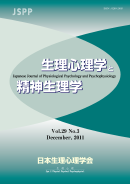All issues

Volume 5 (1987)
- Issue 2 Pages 83-
- Issue 1 Pages 1-
Volume 5, Issue 1
Displaying 1-5 of 5 articles from this issue
- |<
- <
- 1
- >
- >|
-
Relationships with hemispheric asymmetryKenzo KONISHI, Tsunetaka OKITA1987 Volume 5 Issue 1 Pages 1-9
Published: 1987
Released on J-STAGE: November 27, 2012
JOURNAL FREE ACCESSThe hemispheric asymmetry of negative event-related potentials with selective attention was examined in eight adults while the subjects were instructed to detect plant names (targets) among animal names if they were presented in red (or blue) and to ignore those names if they were in blue (or red).
Negativity to names in the attended color was maximum at the vertex and lateralized at the left hemisphere. However, this asymmetry was not found when subjects performed a discrimination on non-verbal task. In addition, those data on reaction time suggested that the attentional negativity developed during a stimulus discrimination depending on whether the relevant item was a target.
The negativity was interpreted as partially reflecting a processing stage associated with the target discrimination for a relevant stimulus.View full abstractDownload PDF (1077K) -
Yoshiharu HIROSHIGE1987 Volume 5 Issue 1 Pages 11-19
Published: 1987
Released on J-STAGE: November 27, 2012
JOURNAL FREE ACCESSThe present study examined slow eye movements (SEMs) during early sleep in twenty female subjects, aiming at the detection of hypnagogic state. SEMs were recorded as slow deflections on a pair of horizontal EOGs with the opposite polarity-a phase method (Rechtschaffen & Kales, 1968). SEMs were prominent at the beginning of EEG stage 1, and they terminated when stage 2 lasted about 5 min and kept stable. No recovery of SEMs was seen during slow wave sleep. Analyses of a rising angle revealed that SEM wave form became slower with the progress of sleep. All epochs of the first SEM and 70% of maximum SEMs fell into stage W, preceding the first stage 1. Sleepiness, which subjects signaled by pressing a button switch, induced significant increases in SEMs, whether or not stage 1 developed. These data suggest that SEMs can give a useful criterion to define the temporal range of hypnagogic state.View full abstractDownload PDF (919K) -
Mitsuo HAYASHI, Tadao HORI, Sukeo SUGIMOTO1987 Volume 5 Issue 1 Pages 21-28
Published: 1987
Released on J-STAGE: November 27, 2012
JOURNAL FREE ACCESSThe fluctuations of daytime sleepiness were studied in 8 male subjects (20-22 y). After nocturnal sleep (23 : 00-07 : 00), subjects were assessed their daytime sleepiness at 30-min intervals (08 : 00-19 : 00) by three measures ; Multiple Sleep Latency Test (MSLT), Kwansei-Gakuin Sleepiness Scale (KSS) and EEG. MSLT scores and amplitudes of the theta and the alpha bands of Cz EEG showed significant periodicity of approximately 90 min corresponding to basic rest activity cycle (BRAC). KSS scores and amplitudes of the delta band of EEG showed much slower rhythms than 90 min. These data show that daytime sleepiness fluctuates with ultradian rhythms. The variations of periodicity amomg the five indices suggest that the fluctuations of daytime sleepiness are composite of multiple factors.View full abstractDownload PDF (653K) -
Takehiko YAMAMURA1987 Volume 5 Issue 1 Pages 29-38
Published: 1987
Released on J-STAGE: November 27, 2012
JOURNAL FREE ACCESSLaboratory and field researches on the psychophysiological detection of deception (PDD) in the criminal investigation are reviewed and evaluated in order to provide some informations on the usefulness of polygraph techniques. The history of lie detection and its scientific methodology to assess the various physiological measures in detecting deception were described. The present review also refers to the validity and the reliability of polygraph technique, which a general scientific acceptance would confirm it if more discrete and sophisticated considerations for PDD in criminal investigations and judicial proceedings were conducted.View full abstractDownload PDF (698K) -
1987 Volume 5 Issue 1 Pages 39-69
Published: 1987
Released on J-STAGE: November 27, 2012
JOURNAL FREE ACCESSDownload PDF (3819K)
- |<
- <
- 1
- >
- >|